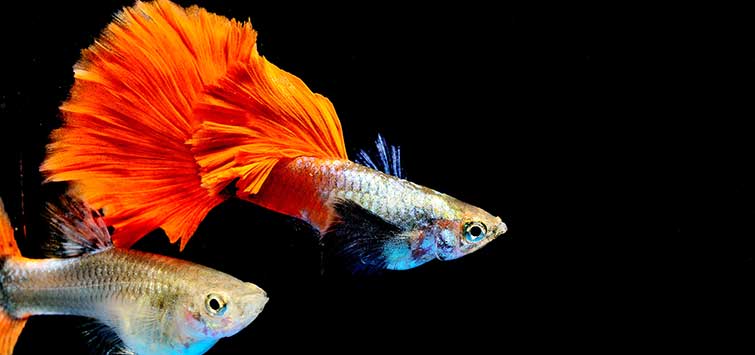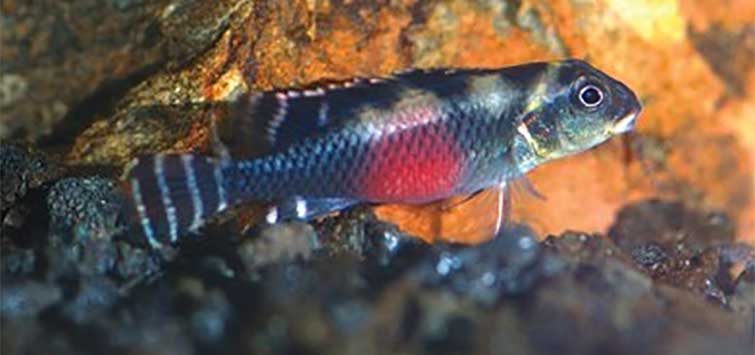Book Excerpt: The 101 Best Freshwater Nano Species
Author: Mark Denaro and Rachel O'Leary
In a peek into another installment of the popular 101 Best fishkeeping book series from TFH/Microcosm, read all about some of the best freshwater shrimps for your nano tank.
Nano-Invertebrate Species: A new world of spineless wonders
Among the most exciting developments in freshwater aquariumkeeping is the growing availability of invertebrate animals, many of them ideally suited for life in a nano-ecosystem. Where generations of aquarists in the past had few invertebrate choices, we now have ready access to a world of ornamental shrimp, micro-crabs, very colorful crayfishes, and snails that are prized for their beauty and not just their grazing talents.
Before simply adding any of the following nano-invertebrates to your system, a few basic background facts are worth knowing. The first has to do with pairing ornamental crustaceans with fishes in a tank: unless the fishes are specialized algae-grazers, if they can eat a shrimp or baby shrimp, they absolutely will. Many of the fish species profiled in these pages have proven to be most suitable for a community tank that includes small invertebrates. But invertebrates are not nearly as flexible as fishes when it comes to water conditions. They will not tolerate any detectable amount of nitrite or ammonia, and only the lowest level of nitrate. Because of this, they need an aquarium that is well cycled and established and a diligent caretaker to maintain it. Many species are also extremely particular about water temperature and hardness, and it is important to research their needs in order to have success.
With invertebrates, stocking density protocol is very different as well. Many more invertebrates than fishes can be housed in a relatively small volume. Hundreds of shrimp can be kept together comfortably, as they are completely peaceful. Attention must be paid to water filtration and oxygenation when keeping any delicate crustaceans. Shrimp-specific tanks that are planted and established need to be fed only a few times a week. Shrimp graze constantly and rarely need large meals.
Crystal Red Shrimp
Caridina cf. cantonensis
(CRS, Red Crystal Bee)
Overview: This dwarf species is one of the most popular because of its vibrant coloration and striking patterning. While more particular about water temperature and pH, it will breed easily given the proper conditions. There is a lot of variety to the patterning available, and the shrimp are graded based on quality of color and striping. These do not hybridize with the genus Neocaridina and the two can be housed together safely. Like all shrimp, they are very sensitive to water quality, so overfeeding should be avoided. A few small meals per week are generally adequate.
Native Range: Southern China for wild types; domestically bred color forms
Maximum Size: 1.2 in. (3 cm)
Minimum Aquarium Size: 2 gal. (8 L)
Water Parameters: pH 6–7.5, 65–75°F (18–24°C)
Feeding: Omnivorous and herbivorous. Feed algae-based pellets or flake, and offer high-protein foods sparingly. Be careful not to overfeed.
Behavior & Care: Slightly more challenging than Neocaridina, Caridina cantonensis comes in a wide range of patterns and colors. Most popular and readily available are the Crystal Red and Crystal Black, which are line-bred forms of the wild bee. Wild bees come in a range of colors, including tan and white, red and white, black and white, and blue and white. The selectively bred species require soft, cooler water and will produce offspring with varying patterns. Selective breeding must be maintained for consistent color patterns.
These shrimp do best in groups of at least five or six adults, and they enjoy a planted aquarium. For best breeding results, they should not be paired with fishes except with caution. Most adult shrimp can cohabitate with dwarf species of fishes that do not get larger than one inch. The most suitable species are those from the Boraras genus, some Breviboras, and Trigonostigma, as well as some specialized grazers like Otocinclus, Parotocinclus, and even some Stiphodon species. One should avoid pairing them with fishes that are micropredators, like danios and most tetras, as they will readily predate upon young shrimp.
Tiger Shrimp
Caridina cf. cantonensis
“Tiger” (Super Tiger)
Overview: Tiger Shrimp are one of the more popular shrimps in the hobby. They reproduce readily in the correct conditions, and can be a striking addition to a small planted tank. Start with at least five or six shrimp as a foundation breeding colony.
Native Range: Southern China
Maximum Size: 1.4 in. (3.5 cm)
Minimum Aquarium Size: 2 gal. (8 L)
Water Parameters: pH 6.5–7.5, 65–75°F (18–24°C)
Feeding: Omnivorous. Be cautious and do not overfeed; like other shrimp species, they are highly sensitive to poor water quality. A good herbivorous pellet or flake should be fed sparingly, no more than a few times a week.
Behavior & Care: There are two main color variations of the wild Tiger Shrimp. The first is grey with dark brown stripes, the second bluish with dark brown stripes. They may have a golden to orange head and tail, and sometimes have white or tan striping behind the dark stripes. Occasionally one comes across one that has red stripes as well, though this is less common. Several mutations have become very popular in the hobby, one of which is a dark blue color. There are also “blondes,” which have light gold eyes. Hybridization between these and bee shrimp is very prevalent, so care should be taken not to house them with others of this genus and species type.
Blue Tiger Shrimp
Caridina cf. cantonensis “Tiger” (Super Tiger)
Native Range: Southern China (captive bred)
Maximum Size: 1.4 in. (3.5 cm)
Minimum Aquarium Size: 2 gal. (8 L)
Tangerine Tiger Shrimp
Caridina serrata
(Orange Tupfel)
Native Range: Southern China
Maximum Size: 1.4 in. (3.5 cm)
Minimum Aquarium Size: 2 gal. (8 L)
Amano Shrimp
Caridina multidentata (Yamato Shrimp, Japonica Shrimp, Algae Shrimp)
Overview: The Amano Shrimp, which readily eats filamentous algae, is truly the workhorse of dwarf shrimps and the most popular addition to a planted tank. They are low-order breeders, so they do not reproduce in fresh water but have a relatively long life span and large size, making them popular in most community tanks. Stock at a rate of up to 10 shrimp per gallon (3.8 L) of water.
Native Range: Taiwan, Japan
Maximum Size: 2 in. (3 cm)
Minimum Aquarium Size: 2 gal. (8 L)
Water Parameters: pH 6.2–8, 70–84°F (21–29°C)
Feeding: Omnivorous. Amano Shrimp will readily eat most algae and are easy to supplement with prepared foods like pellets or flake. If you want them to eat algae, feed supplemental foods sparingly. Avoid food too high in protein.
Behavior & Care: The Amano Shrimp is one of the largest of the dwarf shrimps and can take a wide range of temperatures. Because of their size, they can outcompete smaller shrimp for food, so care should be taken with stocking density in a small tank. Due to their large size, they are an appropriate component of a mix that includes most community type fishes. Many people keep them in discus tanks, as they are tolerant of the higher temperatures and are efficient at cleaning up uneaten foods. Fishes like angels should be avoided, though larger tetras, danios, and most Corydoras catfishes, as well as Ancistrus and Hypancistrus, are appropriate.
Bumblebee Shrimp
Caridina breviata
Overview: This wild shrimp looks very similar to the Bee Shrimp, Caridina cantonensis, but differs in that it almost always has a dark head and generally wide striping ranging from black to brown, with beige or colorless contrasting stripes. Maximum stocking density should be about 10 adult shrimp per gallon (3.8 L).
Native Range: Southern China, captive-bred
Maximum Size: 1.2 in. (3 cm)
Minimum Aquarium Size: 2 gal. (8 L)
Water Parameters: pH 6–7.5, 65–75°F (18–24°C)
Feeding: Omnivorous. Avoid high protein; a range of herbivorous pellets or flakes is appropriate.
Behavior & Care: With the right conditions, this is a relatively hardy shrimp. Make sure to keep its tank cool and well oxygenated. Be cautious of overfeeding, as changes in tank chemistry can be lethal to shrimp. This shrimp can be housed with species of Neocaridina or peaceful fishes 1 inch (2.5 cm) and under. One should avoid housing them with larger, more active fishes, as their young are easy prey. They should not be housed with other species of Asian Caridina (CRS, Tiger, etc.) because there is a strong risk of hybridization.
Sunkist Shrimp
Caridina thambipillai
(Caridina propinqua, Orange Shrimp)
Overview: Commonly found in the pet trade, Sunkist Shrimp are a striking addition to a small planted tank. They are low-order breeders, meaning there is a larval stage for the young, but hobbyists have succeeded in breeding them.
Native Range: Indonesia
Maximum Size: 1.2 in. (3 cm)
Minimum Aquarium Size: 2 gal. (8 L)
Water Parameters: pH 6–8, 75–85°F (24–29°C)
Feeding: Omnivorous. Feed a balanced diet of pelleted or flake foods, avoiding very high protein.
Behavior & Care: This species is a great addition to a planted invertebrate tank, as they won’t hybridize with the other Neocaridina or Caridina species commonly found in the hobby. They are brightly colored, peaceful, and easy to keep. A brown version is also available.
As with all shrimp, care should be taken with tankmates to prevent predation. Small, peaceful species of danios, tetras, microrasboras, and Boraras, as well as small catfishes or loaches from the Petruichthys or Micronemacheilus families, are acceptable. Start a breeding colony with a minimum of five or six shrimp. Maximum stocking density should be about 10 adult shrimp per gallon (3.8 L).
Red Cherry Shrimp
Neocaridina davidi
(Cherry Shrimp, Red Cherry, Red Fire)
Overview: One of the most common and popular freshwater dwarf shrimps, Red Cherry is an excellent choice for the beginning shrimp-keeper. They are relatively durable and accepting of a range of water chemistries, and a striking addition to a small tank. Cherry Shrimp breed readily with good care; the young hatch into miniature versions of the adults.
Native Range: Taiwan, cultivated in pet trade
Maximum Size: 1.2 in. (3 cm), females slightly larger than males
Minimum Aquarium Size: 2 gal. (8 L)
Water Parameters: pH 6–8, 60–82°F (16–28°C)
Feeding: Omnivorous and herbivorous. Feed algae-based pellets and flake; feed high-protein foods sparingly.
Behavior & Care: Cherry Shrimp are extremely peaceful, totally plant-safe, and easy to feed. They will accept a range of foods from pelleted to flake to live, though care must be taken not to overfeed. Offering a small amount of food a few times a week is usually adequate. Excess food should be removed to prevent fouling of the water. Shrimp are best kept in small groups; 10 or more are recommended.
Good tankmates include Nerite snails, algae-eaters like Otocinclus, and small schooling fishes like Boraras brigittae (Chili Rasbora). Fishes with a strong prey drive (barbs, large danios, and large tetras) should be avoided. For the best success in breeding, an invertebrate-only tank is preferred. Several variants of the species have been bred, including the Sakura, Painted Fire Red, Yellow Fire, Orange, Chocolate, and Rili (in various colors). D
Book Excerpt: The 101 Best Freshwater Nano Species By Mark Denaro & Rachel O’Leary ISBN: 978-098202625-0 ©2014 by TFH Publications, Inc. Used with permission.
See the full article on TFH Digital http://www.tfhdigital.com/tfh/october_2014#pg69

.png?h=595&iar=0&w=2781&hash=5FD5E69473BCC22199FBFA2FB71B6033)



